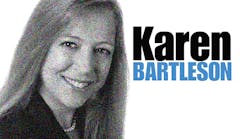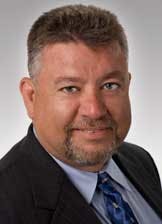Synopsys' Rich Goldman Explains The Effects Of Standards On 2014's Semiconductor Trends
The ever-changing semiconductor industry has experienced and will continue to experience megatrends like no other industry. Recently, Rich Goldman, vice president of corporate marketing and strategic alliances at Synopsys, made his predictions about the top five trends that are likely to drive the global semiconductor industry in 2014. Each of these trends can be helped, or hurt, by the domain of standards.
Standards For FinFETs
Karen: You predict that FinFETs will be one of the top five trends in 2014. FinFETs promise lower power consumption and higher performance. Designing and manufacturing FinFETs involve a slew of challenges. How can standards help overcome some of them?
This file type includes high resolution graphics and schematics when applicapable.
Rich: EDA tools and models are advancing to handle the unique properties and behaviors of FinFETs. For each step in the design cycle, data is transferred from one tool to another. Enabling interoperability and modeling are obvious roles for standards to play and there are already several standards in use today. For example, the Liberty library modeling standard is used to develop FinFET libraries that feed logic synthesis and other advanced tools. Standards for describing low-power design intent are also important. Because low power consumption is a key feature of FinFETs, designers can benefit from using these during the power planning stage. The Unified Power Format (UPF) (IEEE Std. 1801) is effective in capturing the low-power design intent and directing the EDA tools to implement it. The biggest advancements in standards for FinFETs are in the Interconnect Technology Format (ITF) standardized by the IEEE-ISTO and in the new BSIM-CMG (CMOS Multi-Gate) SPICE model.
Related Articles
- How To Get Through The IEEE Standardization Process Step By Step
- Don't Underestimate The Value Of Standards
- Standard-Essential Patents: Innovation's Boon Or Bane?
Karen: Are these standards sufficient for FinFETs today?
Rich: Standards for advanced semiconductor design, including FinFETs, should always evolve. While the standards may suffice for a given technology or geometry node, design and EDA engineers are constantly inventing more effective ways of overcoming challenges. As these engineers learn new techniques, the standards for interoperability and modeling need to be enhanced. It’s a cyclical situation. The standards enable new designs that can render the standards obsolete unless the standards are updated to include new methods and technology. Thus, standards working groups, comprised of tech-savvy engineers and experts in standards development, are part of the overall success of new technologies such as FinFETs.
Standards For IP And Subsystems
Karen: The second trend you predict for the 2014 semiconductor industry is that reuse of intellectual property (IP), which has proven to be essential to modern design, will extend into subsystems. These subsystems will effectively raise the level of abstraction for design reuse. What do standards have to do with IP and subsystems?
Rich: To start with, standards are used as they always have been to design and test the IP blocks themselves. Then, standards are used to integrate the IP into subsystems and other parts of the larger design. Without the EDA and test standards in place today, semiconductor chip designs would not have been able to methodically increase in complexity through reuse. Yesterday’s subsystems are today’s IP, and so it will be in the future. Standards for designing and testing IP and subsystems will continue to be relevant in this evolution.
Karen: Yet successful use of IP depends on another kind of standard too, doesn’t it?
Rich: Yes. Interestingly, IP has to follow certain rules of behavior in order to be interoperable with other parts of the design and even the rest of the electronic product, not just the chip. Perfect examples of this kind of standard are USB, SATA, and 100Gbit Ethernet. IP that supports these standards must behave in a consistent, predictable manner because they provide the interfaces into and out of the chip. In order for components in an electronic product to be “mix and match” or “plug and play,” which product developers and consumers simply demand today, they must rely on IP that follows standards of operation.
Standards For The Internet Of Things
Karen: To me, the most intriguing trend that you include in your prediction is the Internet of Things. The Internet of Things is big and beautiful and scary. It’s going to change the world as we know it. What role will standards play as the Internet of Things comes to life around us?
Rich: The Internet of Things, where devices talk and react to each other and people, is based on two foundational elements. The first element is sensors. The second is communication protocols.
Karen: And there are standards for these?
Rich: Indeed. Sensors that are designed using CMOS chips, for example, make use of all the usual EDA standards. To show how pervasive and extensive standards are, there’s a relatively new standard from the IEEE called 1851-2012 – IEEE Standard for Design Criteria of Integrated Sensor-Based Test Applications for Household Appliances. As for communication protocols, which are communication standards, they make the Internet work. Staples such as HTTP, DCP, and TCP/IP helped create the Internet we depend on today. Communication standards such as Wi-Fi and Ethernet enable computers and devices to interact. The combination of sensor standards and communication standards is the essence of the Internet of Things.
Karen: But people’s trust in the Internet is eroding, isn’t it? In light of government spying, hacking, phishing, identity theft, trolling, spoofing, and spamming, it’s no wonder that people are leery of the Internet of Things. I actually think that if we can’t restore people’s faith in the Internet, there might never even be an Internet of Things. Can standards solve the problem of privacy and security that is plaguing us these days?
Rich: They certainly can make things much better and reduce the fear of the Internet of Things. For privacy and security standards, the interesting paradigm is that they should be created publicly and openly. When a breadth of interested parties, without geographical borders or country allegiances, is allowed to produce a common standard without secret dealings, it is highly unlikely that back doors or other means of hacking will be in the standard.
Karen: Will these privacy and security standards affect the semiconductor industry, though?
Rich: Well, the semiconductor industry provides the foundation for the Internet of Things, so yes, these standards do and will affect us in a couple of ways. The first is technical. If security is implemented in hardware, the chips will have to adhere to the security standards. The second is economic. If people don’t feel secure, they won’t buy the electronic products. The waning of the electronics market will trickle down to the semiconductor industry, which is definitely not good for our future.
Karen: Wow. Standards are becoming even more important for everyday life. That’s what makes them so interesting and difficult. On to the next trend…
Standards For In-House IC Design
Karen: Your fourth trend for 2014 is systems companies bringing IC design in-house. This means that large companies are beginning to believe that they are best suited to design their own ICs rather than having someone else do it for them. This is quite interesting, but what does it mean for standards?
Rich: What it means is a whole new group of standards users and developers is emerging. Experts from companies like Google will need to be trained in how to use standards for design for both interoperability and reuse purposes. Once they begin using the standards, they will become the inventors of new techniques. The natural progression will be for them to contribute back to the evolution of the standards for their future success.
Karen: Beyond just learning about the technical aspects of the standards, won’t they need to learn a little more about the standards arena?
Rich: Yes, because as you know very well, standards are not simply technical in nature. There are market forces to understand and the potentially dangerous area of standard essential patents. The new group of standards users and developers will be wise to heed the advice of semiconductor standards veterans.
Standards For Advanced Designs
Karen: Your last trend is that designs will continue to advance at both established nodes and emerging nodes. The leading edge can be more exciting and perplexing, yet established technology can reduce risk and cost. Again, how do standards fit into this picture?
Rich: Standards fit in very well, and I don’t mean that facetiously. Standards have a long life, making them ideal for use at an established node. They become battle-hardened and highly reliable the longer they are employed. Much like software, the more they are used, the fewer flaws remain. Well-used standards such as SystemVerilog and GDSII can easily be employed on increasingly complex designs at established nodes. In addition, EDA and IP standards can span several nodes, building on the knowledge and expertise gained along the way. They can last a long time, regardless of the chemistry and physics of different nodes. But, and this is important, the standards must progress at some point in order to keep up. Either they need to be updated or new standards must be created. We saw this as the semiconductor industry evolved over the past decade. Verilog gave rise to SystemVerilog and UPF emerged.
Karen: Thanks, Rich. One more question. Would you like to add standards to your top trends for 2014?
Rich: I think I’d actually add standards to the top trends for all time.
This file type includes high resolution graphics and schematics when applicapable.
Karen Bartleson is the senior director of community marketing at Synopsys Inc. She has 30 years of experience in semiconductors, joining Synopsys in 1995 as standards manager. Her responsibilities include initiatives that increase customer satisfaction through interoperability, standards support, university relationships, and social media engagements. She also held the position of director of quality at Synopsys for three years. She was elected president of the IEEE Standards Association for the 2013-2014 term. She holds a BSEE from California Polytechnic University, San Luis Obispo, Calif. She was the recipient of the Marie R. Pistilli Women in Design Automation Achievement Award in 2003. Her first book, The Ten Commandments for Effective Standards, was published in May 2010.


